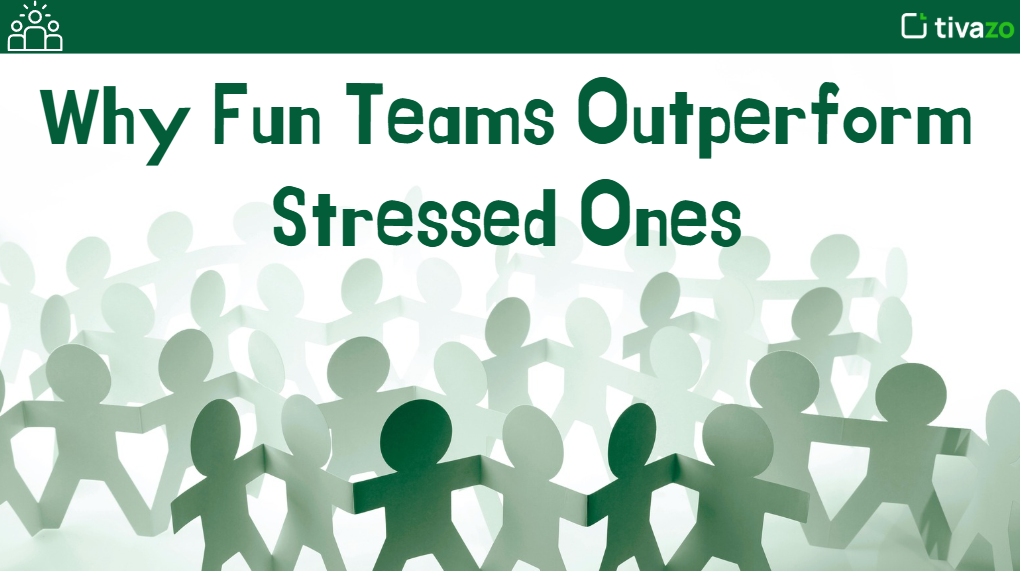In today’s fast-paced, performance-driven work environments, it is often thought that seriousness equates to success. This experience is changing, as there is mounting evidence to the contrary. Fun teams (ones that effectively balance professionalism with a positive sentiment) outperform performance for teams working under stress (and the pressure associated with them).
This isn’t simply about having ping-pong tables or a casual Friday. While a team that engages in fun experiences certainly fosters creativity and develops strong relationships, it’s also a team that produces results without harming their mental health, and it reflects those forms of engagement without harm or a productive outcome. Software products like Tivazo now demonstrate, after cultural analysis about what it means to have engaging dynamics, how much the fun team experiences predict the way productivity, engagement, and performance are predicted over the months or years of a company’s performance.
During this blog, we will be considering the characteristics of working with successful fun teams, how fun teams are associated with a reduction in stress, and how team dynamics are dedicated to producing superior performance outcomes.
You will get to see how behavioral drivers and real-time engagement observations from in-the-moment experiences are evidenced by the software, Tivazo. We will find out how a little bit of fun can go a long way.
What Makes a Team Successful and Fun?
A fun team is not simply one that jokes around in virtual meetings and organizes happy hours. Team success can often be attributed to several things they have in common:
1. Psychological Safety
Team members feel they can be themselves without fear of embarrassment or punishment. This allows for idea-generation and constructive conflict—key components of innovation! When team members understand that their opinion will be valued and respected, they are more likely to offer creative solutions, push back on assumptions, and admit making a mistake without fear of punishment. Trust is the bedrock of open communication and effective problem-solving.
2. Shared Goals and Values
Fun does not mean unfocused chaos. The funniest teams are all focused on collective goals/directions; they just happen to also do so with enthusiasm, collaboration, and shared energy. With a collective understanding of “why” they are doing what they are doing and aligned values, the shared objective becomes a joint journey rather than individuals striving to accomplish a goal.
3. Balanced Framework
Flexibility and framework must coexist. Teams that lean toward fun while also establishing frameworks for functioning well as a group have clear roles and responsibilities but allow room for humor, creativity, and human connection. This balance reinforces that while tasks are stipulated and people are held accountable, it also leaves room to laugh, think differently, and develop real relationships that extend beyond job roles. This is an example of a fun team that is a mixture of flexibility and recognizing a defined structure. You are finding the perfect mix of productivity and fun.
4. Recognition and Celebration
Giving recognition, celebrating little victories of team members, acknowledging personal milestones, or simply bringing humor into your daily stand-ups has a significant impact on morale. These activities help to form emotional connections between team members. Recognizing people’s effort, claiming progress, and acknowledging people’s contributions creates a positive feedback loop that encourages similar behaviors or deeds in the future. Recognizing teammates does not always have to take the form of something formal. A shout-out of some kind, or even a laugh, indicates that the members of the team matter and are valued for a fun team.
With the accountability tools of Tivazo, leaders can start to see trends in engagement, collaboration, teamwork, and teammate dynamics to see what better outcomes relate to. By tracking time-on-task versus time idle, and the team’s rhythm, Tivazo allows businesses to see where fun meets function.
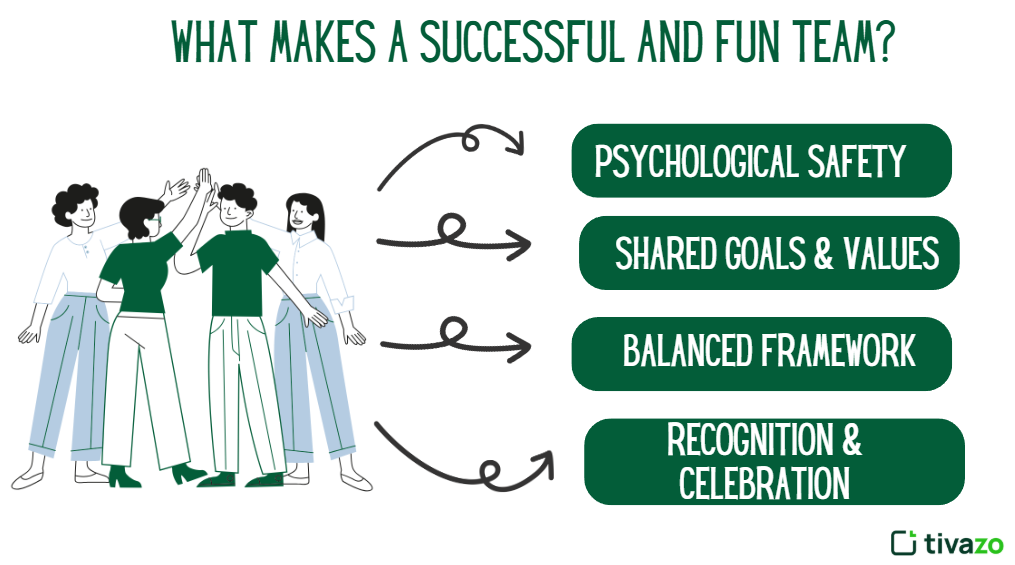
How does teamwork mitigate stress for teammates?
The workplace can produce tremendous stress – the worst kind – stress that weighs upon productivity, creativity, and motivation. While there will always be deadlines and challenges, the ability of the individual to experience stress is impacted tremendously by being part of a cohesive, supportive team. Below is a list of how the fun team mitigates their stress:
1. Emotional Support
Being a part of a team that listens, helps, and encourages is probably one of the best ways to lessen emotional exhaustion. In teams with a culture of fun, empathy is somewhat automatic because team relationships are deeper and more genuine. Knowing that coworkers have your back, will listen, or will lend assistance offers a necessary safety net that can buffer against the pressures and realities of a professional work environment. Just knowing you are part of a group of caring individuals greatly reduces isolation and feelings of being overwhelmed.
2. Shared Responsibility
When teammates work together well, they also tend to share responsibility well. No one teammate is isolated or overwhelmed; tasks are being approached collaboratively. Challenging projects are simply less intimidating when working in tandem, and individual pressure is greatly reduced. Working alone can be relieving.
3. Fewer Conflicts
Fun teams are more apt to make constructive conflict. Miscommunication that could have led to toxic drama is less likely among group members who know and trust each other. Strong relationships, connecting through shared experiences, can give team members a good basis for true connection; for this reason, member disagreements will be considered potential sources of growth rather than personal attacks. Fun teams examine the benefits of conflict they They resolve disagreement situations faster; they also continue with a stronger belief in their use of teamwork to solve problems, thus protecting team cohesion and maintaining clear linkages with team dynamics.
4. Coping Improvements
Teams that laugh together survive better together under pressure. Research has shown that humor lowers cortisol and improves resilience, physically and mentally. Together, laughter acts as a good antidote to stress, and on a personal level, it also lessens tension and increases a more positive outlook on circumstances. Teams that can maintain and appreciate humor, even in stressful situations, signal that the group mentally, together, has very good coping and endurance mechanisms.
Using Tivazo’s time tracking and engagement analysis features, anyone can see early signs of burnout, such as extended idle time, patterns of irregular performance, or performance drops. These data points can help managers intervene sooner (and hopefully with team-building aspects on morale, or schedule revisions).
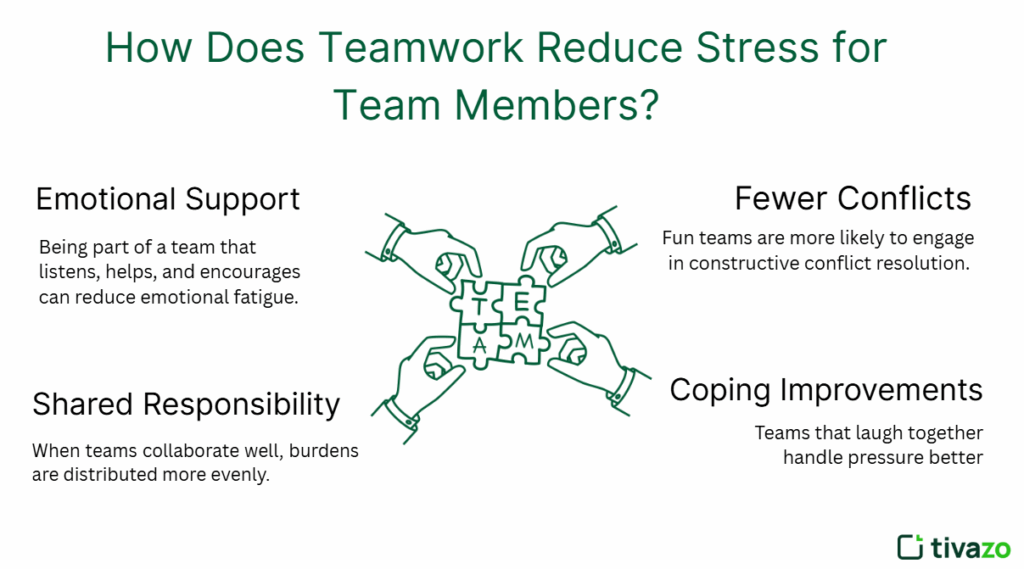
Overcoming Barriers to a Fun Team
There are barriers to building a fun team. Commonplace barriers include:
- Resistance to Change: Some people and leaders are still caught in traditional working mindsets, and they can view “fun” as unprofessional or a distraction. Sharing data like Tivazo can help educate them on the quantifiable benefits of building a fun team culture.
- Limited Time: In fast-working environments, making time can seem impossible. However, we must consider creating a fun team culture as an investment in productivity and wellness instead of a time suck.
- Remote/Hybrid Barriers: Building rapport with coworkers or being spontaneous can be more difficult during times of remote work or hybrid work. This is where your intentionality is even more important. Virtual coffee breaks, team activities online, and “non-work” channels are all examples of how important it is to intentionally build connections when working from home.
- Limited Leadership commitment: If your leadership doesn’t “lead” these behaviours daily, it may be hard to create a fun and supportive culture. Leadership must demonstrate the desired behaviours and visibly allocate resources toward team-building efforts.
The Long-Term Benefits: Beyond Productivity
The advantages of a fun team are much larger than simply improving productivity. Over time, an enjoyable work environment encourages:
- Reduced turnover: A happy and engaged workforce is also a more stable workforce. The cost of replacing employees is a major drain, and a fun team is a great retention tool!
- Stronger Employer: Brand Companies that are known for making the workplace enjoyable and fun will have a competitive advantage in the eyes of top talent. Fun companies will be able to recruit faster and more successfully.
- Increased Innovation: Innovation can only occur when people feel safe enough to play and share unconventional thinking. Fun teams naturally help with out-of-the-box thinking and creative solution finding for complex problems.
- Increased Resilience: Teams that have positive and resilient relationships and coping mechanisms are going to make it through their setbacks and crises, so they can thrive in a changing marketplace.
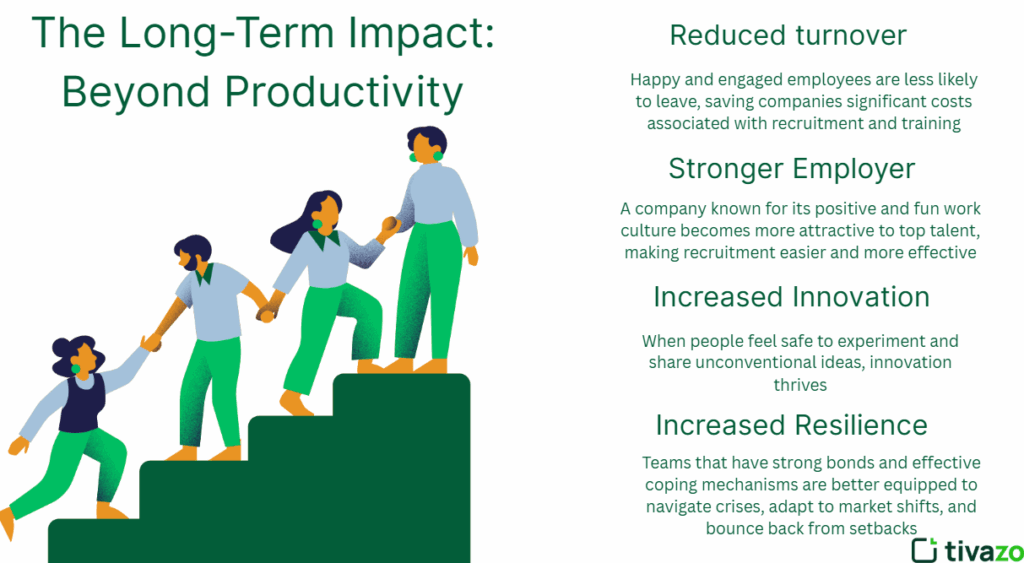
Why Do Some Teams Function Better Than Others?
This is a good question: why are there some teams that jell easily while others struggle with conflict and inefficiency?
1. Culturally Fit
Teams that have compatible communication styles, work styles, and values are more comfortable with each other and will succeed. Fun teams normally have a good culture fit on the soft elements, even if their skill sets are different. It is not about wondering why they have such different personalities. It is about how they understand how to get the work done, how to provide feedback, and how to respect one another’s work and lives. When culturally aligned, collaboration can feel easy and natural.
2. Understanding Role
When everyone is clear about their roles and the roles of their teammates, teams function more effectively. Fun teams apply the same consideration and respect to the roles they define and use them to build upon each other. When everyone has clearly defined roles, there are fewer misunderstandings, less repeated effort, and individual team members will take ownership of their role in the work with an understanding of the larger purpose.
3. Effective Leadership
A fun, functional team has leaders who inspire collaboration without being directly involved. Good leaders promote humor, recognition, and growth. A good leader creates an atmosphere of inspiration and trust, actively promoting and encouraging a culture of experimentation, profile, positivity, and viewing failure as a learning opportunity. Good leaders don’t just delegate, they inspire and empower.
4. Adaptability
Teams that exhibit change, learn from failure are often progressing quickly. Fun teams often advocate experimentation and developing creative solutions to problems without blame. Being agile is also important when the business is changing quickly. A team that can change, learn from missteps, and continue improving will always outperform inflexible teams and those who reject new ideas or ways of doing things. These are small yet crucial examples and how a fun team can perform better, making a difference.
Tivazo allows managers to see which teams are completing tasks the quickest, which teams are collaborating more actively, and which teams are showing signs of internal friction. Once leadership regularly reviews this data, they can take proactive steps to simply reassign, restructure, or support teams.
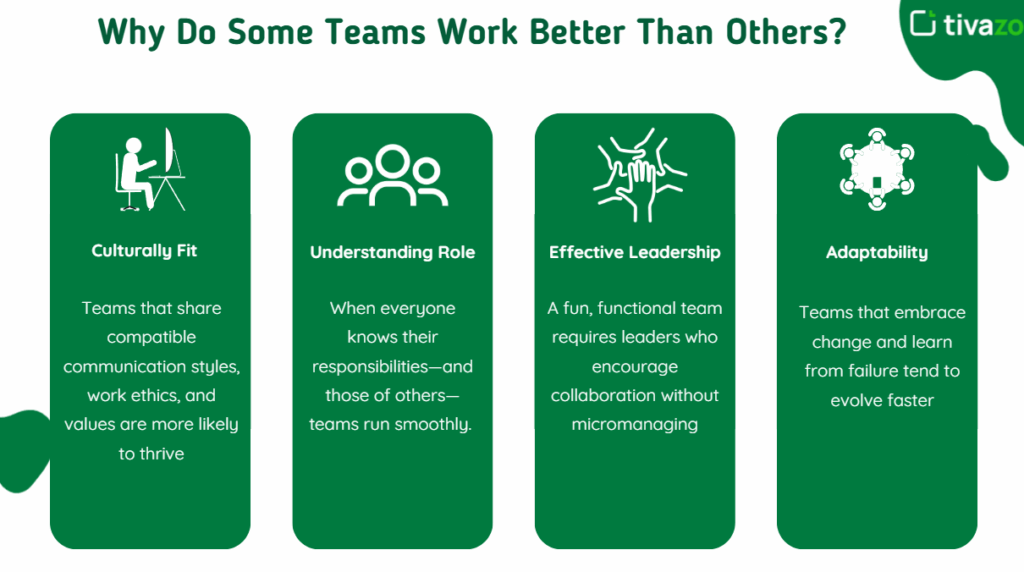
Why Does Teamwork Influence Employee Performance?
Teamwork is not only about having a good time, but it’s also about better performance. Teamwork can influence performance because it can:
1. Increase Productivity
When teams work together effectively, they get the work done faster and with fewer mistakes. The team leverages their strengths and each other’s, creating less redundancy and allowing for greater efficiencies. The energy created by a team is important; with a good team, the output of the work will always be greater than the sum of the individuals’ contributions. This team dynamic gets us online with the full presence of diversity in skills and perspectives.
2. Enhance Engagement
Belonging to a fun, winning team creates a sense of intrinsic motivation. Engaged employees will consistently give their best effort, will have more focus on the work and configurations, and will go the extra mile. When the work is fun and interesting, and it has meaning, employees will be more dedicated and committed to the team’s success. Meaningful work allows for an increase in quality, and employees will be more willing to accept the responsibility of the work.
3. Facilitates Learning
Collaborative teams allow for informal peer learning. In a fun team, employees are open to sharing knowledge and mentoring others and are eager to learn collaboratively. The permanent sharing of knowledge and expertise within a fun team leads to a more skilled and flexible workforce. Mistakes become learning opportunities, and the successes can be celebrated as a team to create a culture of improvement and excellence.
4. Decreased Absenteeism
When work is fun, people show up. Strong teams often reduce sick days, improve retention, and reduce turnover. People are more likely to be present (both physically and mentally) when they feel connected to other team members and a sense of purpose to what they are doing. Fun and supportive teams provide little impetus to disengage or look for work elsewhere.
Using Tivazo’s real-time dashboards, managers can assess how their team’s culture and dynamics are contributing to their team’s overall performance. For example, Tivazo may show that “Team A” (with the fun culture) records billable hours more than “Team B” (stress-based environment). This is a powerful data point showing the business value in building fun teams.
Conclusion
From culture to outcomes, fun teams win.
With stress and turnover on the rise, the opportunity to foster emotionally connected, collaborative, and fun team experiences is a skill, not an option. Tools like Tivazo can help you measure what matters. Evidence shows aligned, fun teams consistently outperformed stressed teams across the engagement, creativity, and productivity metrics.
Whether you’re remote, hybrid, or in-office, these shifts begin with shifting mindset: work can be fulfilling and fun! When teams feel safe, supported, and energized, businesses can expect outputs and sustainable long-term success. Businesses that capitalize on these opportunities will be able to innovate, retain, and scale more effectively and sustainably.
